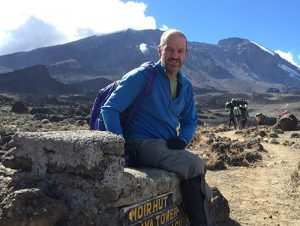Researchers climb Mt Kilimanjaro to unlock altitude sickness

Norman Morris at Lava Tower (4,600m) where the group stopped to check their oxygen
saturations.
Professor Norman Morris, who works at both TPCH and Griffith University, and fellow TPCH physiotherapist Helen Seale, embarked on a research study in August, which involved trekking the highest mountain in Africa.
The two joined 30 others on an adventure experiment up Mount Kilimanjaro in Tanzania.
The expedition was led by a long-time collaborator of Professor Morris’ Professor Bruce Johnson from the Mayo Clinic, who previously undertook studies in Mount Everest in Nepal, Aconcagua in Argentina and a 3-year study in the South Pole to study the effects of altitude sickness.
Helen and Norman performed short exercise tests on the climbers and researchers as they climbed.
Two portable metabolic carts were used to measure gas exchange, oxygen saturation and heart rate.
The purpose of the trip was to measure how altitude affected the body by looking at a range of variables including altitude symptoms, sleep quality, day/night time oxygen saturation, cardiac function using echocardiography and electrocardiogram, lung function, energy expenditure and body composition.
Follow Norman’s adventure on his website.
